Exhibit: Indigenous Contributions to the War of 1812

The Aboriginal Contributions to the War of 1812 exhibit was created to commemorate the contributions of several First Nation groups and the Métis fighters throughout the War of 1812. The ten panels below demonstrate the progression of the war, its impact on First Nations and Métis fighters, and present-day recognition of Aboriginal participation in this important conflict, while at the same time highlighting some of the key battles and significant figures of the war.
Table of contents
Panel 1
PDF Version (352 Kb, 1 Page)
Aboriginal Contributions to the War of 1812
Throughout Canada's history, Aboriginal peoples have helped shape this land into the country we know today. Before Canada became a country, Britain's military alliances with First Nations were a key part of the defensive network of British North America. During the War of 1812, First Nations warriors and Métis fighters played important roles in the defence of these British territories against invading American forces. Thousands of First Nations warriors and Métis fighters fought beside British troops and Canadian settler militias during the war. These Aboriginal allies were often accompanied by officials from the Indian Department who spoke Aboriginal languages and who could help First Nations war chiefs and British military commanders speak to each other. First Nations and Métis communities sided with the British during the war because they shared a common goal: to resist American expansion. In Canada, the war was fought on three main fronts: in the Western Great Lakes region, the Niagara region and the St. Lawrence region.
Panel 2
PDF Version (406 Kb, 1 Page)
The Causes of the War
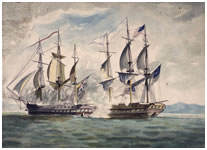
Library and Archives Canada, Acc. No. 1970-188-1158, W.H. Coverdale Collection of Canadiana
After the fight for independence from Great Britain in the American Revolution (1775-1783), tensions between the United States and its former mother country continued. Overlapping territorial claims were a significant motivating factor for the war. Many Americans resented British support for First Nations' claims to territory in the American northwest, land the Americans desired for settlement. The British maintained alliances with these American First Nations, encouraging them to resist American expansion. Some Americans even believed that all of British North America properly belonged with the United States and that Canada should have been conquered during the Revolution.
In addition, the Napoleonic Wars (1803-1815) in Europe caused Britain to adopt maritime policies that the Americans felt infringed on their national sovereignty. The Americans became upset when Britain stopped American ships from trading with France and began impressing American sailors into the Royal Navy. This perpetuated anti-British sentiments in the United States.
Calling Aboriginal Allies
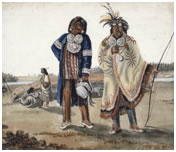
Library and Archives Canada, Acc. No. 1981-55-41, Bushnell Collection
Preoccupied with the Napoleonic Wars in Europe, the British were ill-prepared to fight a war in North America. Strong military alliances with First Nations groups were vital for the defence of Canada in the event of a conflict with the United States. The Indian Department, forerunner of Aboriginal Affairs and Northern Development Canada, strived to bolster these alliances as war became imminent. When the United States officially declared war on Great Britain on June 18th, 1812, and proceeded with plans to invade the colony of Canada, significant numbers of Aboriginal people answered Britain's call to arms. American First Nations, such as the Wyandot, Menominee, Shawnee and Dakota, chose to fight on the side of the British. First Nations from Upper Canada, including the Six Nations, Mississauga and Chippawa, and from Lower Canada, including the Huron-Wendate, Abenaki, Algonquin and Mohawk, as well as Métis fighters of Corps of Canadian Voyageurs, also sided with the British.
Panel 3
PDF Version (1.11 Mb, 1 Page)
Major Battles
1812
- June 18 – Declaration of War
- July 17 – Fort Mackinac
- August 15 – Fort Dearborn (Chicago)
- August 16 – Fort Detroit
- September 3-6 – Western Raids
- October 13 – Queenston Heights
1813
- January 22 – Frenchtown
- April 27 – York (Toronto)
- April 28 - May 9 – Fort Meigs
- May 25-27 – Fort George (Niagara)
- June 6 – Stoney Creek
- June 24 – Beaver Dams
- August 2 - Fort Stephenson (Ohio)
- October 5 - Thames
- October 26 - Châteauguay
- November 11 - Crysler's Farm
- December 19 - Fort Niagara
1814
- March 4 - Battle of Longwoods
- July 3 - Fort Erie
- July 5 - Chippawa
- July 17-20 - Prairie du Chien
- July 25 - Lundy's Lane
- August 4-5 - Michilimackinac
- August 15 - Fort Erie
- November 5 - Niagara Peninsula
- December 24 - Treaty of Ghent
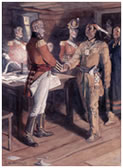
Library and Archives Canada,
Acc. No. 1972-26-1360
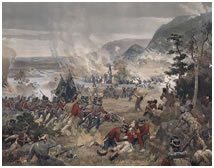
Library and Archives Canada,
Acc. No. 1954-153-1

Odawa War Chief
Beaverbrook Collection of War Art,
CWM 19840034-002, Canadian War Museum
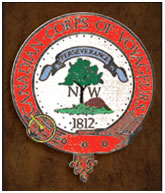
John Robertson, 1974

Library and Archives Canada, Acc. No. 1970-188-1431 W.H. Coverdale Collection of Canadiana
Panel 4
PDF Version (161 Kb, 1 Page)
The Surrender of Fort Mackinac
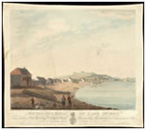
Library and Archives Canada, Acc. No. R9266-1465, Peter Winkworth Collection of Canadiana
On July 17th, 1812, the British set out to capture Fort Mackinac on Michilimackinac Island (near Sault Ste. Marie) from the Americans. The British assembled a force consisting of a small garrison of 46 veteran regular soldiers, 180 Canadian voyageurs and fur traders, most of whom were Métis, and over 300 Ottawa, Ojibwa and Dakota warriors. Unaware that the war had begun, Fort Mackinac's garrison of 61 men were surprised and quickly surrendered.
The Surrender of Detroit

Library and Archives Canada, Acc. No. 1972-26-1360
On August 16th, 1812, Tecumseh led 600 Ojibwa, Ottawa, Pottawatomi and Shawnee warriors across the Detroit River to capture Fort Detroit; British Major-General Sir Isaac Brock crossed shortly after with his force of 330 regulars and 400 militiamen. Though outnumbered, Brock and Tecumseh worked together, spreading out their forces to create the illusion of greater numbers to intimidate the Americans. It worked; the Americans were terrified by the presence of First Nations warriors and quickly surrendered Detroit.
The Battle of Queenston Heights
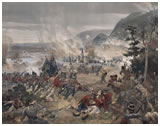
Library and Archives Canada, Acc. No. 1954-153-1
On October 13th, 1812, American troops invaded along the Niagara border, resulting in the Battle of Queenston Heights. During the battle, Brock led a dramatic uphill charge, but was struck in the chest by a bullet and killed. Nevertheless, the British secured victory with the aid of 300 Six Nations warriors, led by Mohawk War Chiefs John Norton (Teyoninhokarawen) and John Brant (Ahyouwaeghs). The brilliant tactical decisions made by Norton in particular helped secure British victory.
The Battle of Beaver Dams
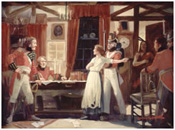
Library and Archives Canada, Acc. No. 1997-229-2, C-011053
First Nations warriors from the Niagara region and some warriors from Lower Canada played a critical role in the defeat of the Americans at the Battle of Beaver Dams on June 24th, 1813. There, Americans attempted a surprise attack, but were ambushed by the Caughnawaga, Kanesatake, Akwesasne and Six Nations Mohawks led by John Norton and John Brant, and Dominique Ducharme and William Kerr of the Indian Department.
Panel 5
PDF Version (315 Kb, 1 Page)
Tecumseh, Shawnee War Chief (1768-1813)
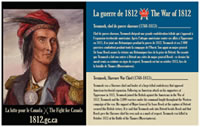
Tecumseh was a Shawnee chief and leader of a large tribal confederacy that opposed American territorial expansion. Following an American attack on his supporters at Tippecanoe in 1811, Tecumseh joined the British against the Americans in the War of 1812. Tecumseh and the 2,000 warriors under his command fought throughout the Western campaign of the war. His support of Major-General Sir Isaac Brock at the capture of Detroit secured this British victory. It is said that Tecumseh rode into Detroit beside Brock and that Brock gave the Shawnee chief his own sash as a mark of respect. Tecumseh was killed in October 1813 at the Battle of the Thames (Moraviantown).
John Brant (Dekarihokenh, Ahyouwaeghs, Tekarihogen), Mohawk War Chief (1794-1832)
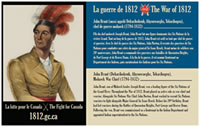
Library and Archives Canada, Acc. No. 1970-189-19. Coverdale Collection of Canadiana
John Brant, son of Mohawk leader Joseph Brant, was a leading figure of the Six Nations of the Grand River. Throughout the War of 1812, Brant played an active role as war chief and warrior. Alongside Six Nations War Chief John Norton, Brant worked to recruit Six Nations warriors to fight alongside Major-General Sir Isaac Brock. Before his 20th birthday, Brant had led warriors during the Battles of Queenston Heights, Fort George and Beaver Dams. Following the war, Brant was commissioned as a lieutenant in the Indian Department and appointed Indian superintendent to the Six Nations.
Métis Fighters in the War of 1812

Throughout the War of 1812, Métis fighters played an active and vital role in the defence of Upper Canada. Métis fighters, along with French-Canadian voyageurs employed by the North-West Company, volunteered to take up arms against the American invaders. The Métis initially served as members of the Corps of Canadian Voyageurs and later the Commissariat Voyageurs, a corps created to arm Métis and French-Canadian voyageurs. The Métis participated in several key battles such as the Battle of Fort Mackinac and raids in American territories, while maintaining trade and transporting supplies throughout British territory.
Panel 6
PDF Version (165 Kb, 1 Page)
Chief Oshawana (John Naudee), Walpole Island

From Walpole Island on Lake St. Claire, Oshawana, also known as John Naudee, had close links throughout both British and American territories. A long-time supporter of Tecumseh's efforts to create a strong confederacy against the Americans, Oshawana participated in several battles on the Western Frontier such as Frenchtown, Fort Detroit and Fort Meigs alongside numerous warriors from Walpole Island. He was often described as Tecumseh's chief warrior. After the death of Tecumseh at the Battle of the Thames, Oshawana became the principle First Nation warrior of southwestern Upper Canada and continued to support the British until the very end of the war.
John Norton (Teyoninhokarawen or "the Snipe"), Six Nations War Chief (ca. 1765-1831)
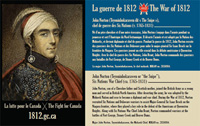
John Norton, son of a Cherokee father and Scottish mother, joined the British Army as a young man and served in British North America. After deserting the army, he was adopted by the Mohawk Nation and rose to become a diplomat and war chief. During the War of 1812, Norton recruited Six Nations and Delaware warriors to assist Major-General Sir Isaac Brock on the Niagara frontier, where they played a key role in the defeat of the Americans at Queenston Heights. Along with Six Nations War Chief John Brant, Norton commanded warriors at the battles of Fort George, Stoney Creek and Beaver Dams.
For more details regarding this postcard…
Wabasha (Waa-Pa-Shaw IV), Dakota, Captain and War Chief (ca. 1765/77-1836)
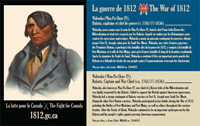
Wabasha, also known as Waa-Pa-Shaw IV, was chief of a Kiowa tribe of the Mdewakanton and was highly respected by the Dakota. Called to support the British against American aggressions, Wabasha led a strong contingent of Dakota warriors to Fort St. Joseph near Sault Ste. Marie. Alongside other First Nation warriors, Wabasha participated in key battles during the War of 1812, including the Battle of Fort Mackinac and Fort Meigs, as well as others throughout the western frontier. After the Treaty of Ghent, Wabasha continued to be an important spokesperson for the Dakota and his people's rights against growing American expansionism.
Panel 7
PDF Version (290 Kb, 1 Page)
The Battle of Moraviantown

The Battle of Moraviantown on October 5th, 1813, was a bitter struggle involving 500 First Nations warriors. Under the leadership of Tecumseh, First Nations warriors put up a long resistance before finally being defeated by the Americans. While the British commander fled, Tecumseh remained to fight and was ultimately killed. The death of Tecumseh was a tremendous blow to the unity of the Western Nations and effectively ended the British alliance with the Shawnee and other American First Nations.
The Battles of Châteauguay and Crysler's Farm
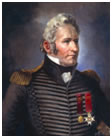
On October 26th, 1813, Lieutenant-Colonel Charles de Salaberry, French-Canadian Voltigeurs and a mixed force of Mohawk, Huron and Abenaki warriors confronted the Americans at Châteauguay just outside of Montreal. Together they managed to repel the American invaders without the aid of the British military. The following month, a mixed force of British regulars, militia, and Mohawk and Algonquin warriors repelled the advancing Americans at Crysler's Farm on the St. Lawrence, causing the Americans to abandon their St. Lawrence Campaign.
The Battle of Lundy's Lane
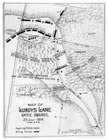
On July 25th, 1814, British troops, Canadian militia and Six Nations warriors of the Niagara region fought to a stalemate at the Battle of Lundy's Lane. It was one of the bloodiest battles of the war and one of the deadliest ever fought on Canadian soil. Ultimately, the battle was a strategic victory for the British, since the American invaders in Niagara suffered so many casualties that they were badly outnumbered and were forced to retreat.
The War in the West
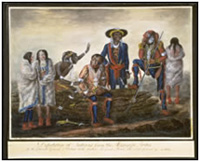
Library and Archives Canada, Acc. No. 1989-264-1
First Nations warriors were key actors in the western theater of the war, carrying out raids on American troops. The British maintained the upper hand in the west until the end of the war due largely to alliances with American First Nations who sought to defend their homelands around the Mississippi River from the Americans. These First Nations warriors, such as the Dakota, harassed and attacked American troops as far west as Fort Dearborn (present-day Chicago).
Panel 8
PDF Version (174 Kb, 1 Page)
War's End
The Treaty of Ghent and Post-War Conferences

Facing a stalemate, the Americans and British met in Ghent, Belgium, to put an end to the two and a half year conflict. On December 25th, 1814, a peace treaty was signed. The Treaty of Ghent largely restored relations between the Americans and the British to the state they were before the war; no territory was lost by either nation and as a result, both nations felt victorious.
The British recognized that they could not have defended the colony of Canada without the participation of their Aboriginal allies. In order to honour them for their meritorious military service, the British met with First Nations chiefs at a series of post-war conferences in Burlington where military banners and silver peace medals were presented to First Nations groups who had fought alongside British forces.
Impact of the War on First Nations
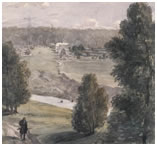
Britain's First Nations allies from the American northwest were generally left isolated after the war. Many returned to their homelands, but American expansion into their territory continued. Some chose to negotiate with the Americans in an attempt to retain some of their land, while others fought the American advance. Regardless, the tide of settlement into Ohio, Indiana and Illinois eventually pushed First Nations, such as the Dakota, to the west and north of their traditional territories. Many First Nations in the United States eventually migrated to Canadian territory.
For First Nations in Canada, the end of the war marked a shift in Indian Policy. Once peace with the Americans had been established, the British stopped cultivating military alliances with First Nations. The Indian Department renewed the process of obtaining Indian land surrenders in order to accelerate settlement. The post-war era also saw an increase in "civilization" programs, assimilationist policies to settle First Nations people on reserve lands, which had devastating consequences for First Nations communities and cultures.
Panel 9
PDF Version (217 Kb, 1 Page)
Memory
The Traditional Narrative of the War of 1812 in Canadian History

Library and Archives Canada / C-085127
The important role played by Aboriginal people in the War of 1812 has not been well remembered. Throughout the traditional histories of the war, First Nations and Métis are either described as playing a "support role" in the military campaigns or not mentioned at all. Most references to Aboriginal participation in the war tend to focus on Tecumseh and his Shawnee followers, and make only passing references to the Six Nations, the Ojibway, the Dakota or the Mississauga. However, the historical documents indicate that First Nations and Métis were active combatants in nearly every single major battle of the war.
The Significance of 1812 to First Nations and Métis
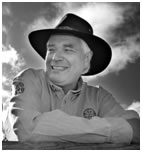
"And when the war ended, the Americans drove the native tribes from the Ohio Valley and elsewhere onto the Great Plains. Native warriors, although they would participate in several future battles, would never again play such a prominent role in the defence of Upper Canada. In Canada, the government began herding native people onto small reserves and to sell or give their lands to settlers. Then as the century progressed, the government launched a social engineering program 'to kill the Indian in the child' by removing the sons and daughters of native people and sending them to residential schools, where they were often brutalized.
Wouldn't it be a great idea if on this bicentennial we highlighted the role of the native warriors, especially the often overlooked ones from Upper Canada who stepped forward to help the British defend Canada in that critical first year of the conflict?"
Panel 10
PDF Version (420 Kb, 1 Page)
The Bicentennial Commemorations
The Commemoration of the War
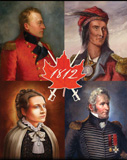
June 2012 marked the beginning of the 200th Anniversary of the War of 1812, an important milestone in the lead-up to the 150th anniversary of Canada's Confederation in 2017.
This commemoration is just one of the many events that are bringing Canadians together and will continue to link us in the years to come.
The Government of Canada recognizes the War of 1812 as a defining moment in the history of our nation and has big plans to commemorate this event of national and international significance. The 200th anniversary of the War of 1812 is an unprecedented opportunity for all Canadians to take pride in our traditions, and our shared history.
Together, the Government of Canada will strive to increase Canadians' knowledge of the War of 1812, an event that was key to ensuring our country's existence and shaping our identity as Canadians.
War of 1812 Commemorative Medal and Banner

The Government of Canada is drawing on tradition to commemorate the contributions of Aboriginal people in the War of 1812. At the end of the war, military banners and medals were presented to Aboriginal groups who had fought alongside British forces. The banners were awarded by the British Army and the medals, known as the King George III War of 1812 Indian Peace Medals, were issued by the government as symbolic acts of gratitude and recognition to the Crown's Aboriginal allies. In order to strengthen the recognition of Aboriginal efforts, Aboriginal Affairs and Northern Development Canada has developed commemorative War of 1812 medals based on the original medal design. These commemorative medals will be presented to 48 First Nation and Métis communities with a heritage linked to the War of 1812. This National Recognition Ceremony takes place on October 25th, 2012, at Rideau Hall.